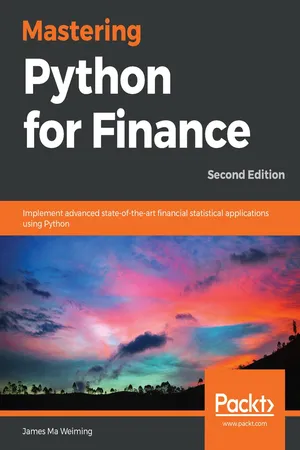
Mastering Python for Finance
Implement advanced state-of-the-art financial statistical applications using Python, 2nd Edition
- 426 pages
- English
- ePUB (mobile friendly)
- Available on iOS & Android
Mastering Python for Finance
Implement advanced state-of-the-art financial statistical applications using Python, 2nd Edition
About this book
Take your financial skills to the next level by mastering cutting-edge mathematical and statistical financial applications
Key Features
- Explore advanced financial models used by the industry and ways of solving them using Python
- Build state-of-the-art infrastructure for modeling, visualization, trading, and more
- Empower your financial applications by applying machine learning and deep learning
Book Description
The second edition of Mastering Python for Finance will guide you through carrying out complex financial calculations practiced in the industry of finance by using next-generation methodologies. You will master the Python ecosystem by leveraging publicly available tools to successfully perform research studies and modeling, and learn to manage risks with the help of advanced examples.
You will start by setting up your Jupyter notebook to implement the tasks throughout the book. You will learn to make efficient and powerful data-driven financial decisions using popular libraries such as TensorFlow, Keras, Numpy, SciPy, and sklearn. You will also learn how to build financial applications by mastering concepts such as stocks, options, interest rates and their derivatives, and risk analytics using computational methods. With these foundations, you will learn to apply statistical analysis to time series data, and understand how time series data is useful for implementing an event-driven backtesting system and for working with high-frequency data in building an algorithmic trading platform. Finally, you will explore machine learning and deep learning techniques that are applied in finance.
By the end of this book, you will be able to apply Python to different paradigms in the financial industry and perform efficient data analysis.
What you will learn
- Solve linear and nonlinear models representing various financial problems
- Perform principal component analysis on the DOW index and its components
- Analyze, predict, and forecast stationary and non-stationary time series processes
- Create an event-driven backtesting tool and measure your strategies
- Build a high-frequency algorithmic trading platform with Python
- Replicate the CBOT VIX index with SPX options for studying VIX-based strategies
- Perform regression-based and classification-based machine learning tasks for prediction
- Use TensorFlow and Keras in deep learning neural network architecture
Who this book is for
If you are a financial or data analyst or a software developer in the financial industry who is interested in using advanced Python techniques for quantitative methods in finance, this is the book you need! You will also find this book useful if you want to extend the functionalities of your existing financial applications by using smart machine learning techniques. Prior experience in Python is required.
Frequently asked questions
- Essential is ideal for learners and professionals who enjoy exploring a wide range of subjects. Access the Essential Library with 800,000+ trusted titles and best-sellers across business, personal growth, and the humanities. Includes unlimited reading time and Standard Read Aloud voice.
- Complete: Perfect for advanced learners and researchers needing full, unrestricted access. Unlock 1.4M+ books across hundreds of subjects, including academic and specialized titles. The Complete Plan also includes advanced features like Premium Read Aloud and Research Assistant.
Please note we cannot support devices running on iOS 13 and Android 7 or earlier. Learn more about using the app.
Information
Section 1: Getting Started with Python
- Chapter 1, Overview of Financial Analysis with Python
Overview of Financial Analysis with Python
- Setting up Python, Jupyter, Quandl, and other libraries for your environment
- Downloading datasets from Quandl and plotting your first chart
- Plotting last prices, volumes, and candlestick charts
- Calculating and plotting daily percentage and cumulative returns
- Plotting volatility, histograms, and Q-Q plots
- Visualizing correlations and generating the correlation matrix
- Visualizing simple moving averages and exponential moving averages
Getting Python
$ python --version
Python 3.7.0
Preparing a virtual environment
$ pip install virtualenv
$ cd my_project_folder
$ virtualenv my_venv
$ source my_venv/bin/activate
$ my_project_folder\my_venv\Scripts\activate
Running Jupyter Notebook
$ pip install jupyter
$ jupyter notebook
...
Copy/paste this URL into your browser when you connect for the first time, to login with a token:
http://127.0.0.1:8888/?token=27a16ee4d6042a53f6e31161449efcf7e71418f23e17549d
Table of contents
- Title Page
- Copyright and Credits
- Dedication
- Contributors
- About Packt
- Preface
- Section 1: Getting Started with Python
- Overview of Financial Analysis with Python
- Section 2: Financial Concepts
- The Importance of Linearity in Finance
- Nonlinearity in Finance
- Numerical Methods for Pricing Options
- Modeling Interest Rates and Derivatives
- Statistical Analysis of Time Series Data
- Section 3: A Hands-On Approach
- Interactive Financial Analytics with the VIX
- Building an Algorithmic Trading Platform
- Implementing a Backtesting System
- Machine Learning for Finance
- Deep Learning for Finance
- Other Books You May Enjoy